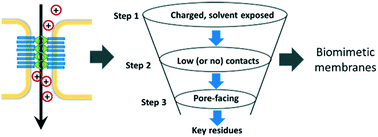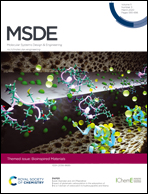Predicting selectivity of paracellular pores for biomimetic applications
Abstract
Biological systems exhibit diverse examples of controlled solute permeability and selectivity in cell and tissue barriers. The epithelial and endothelial cells lining each organ confer selectivity via tight junctions, physical fence-like structures that regulate paracellular transport, whose primary functional component is a claudin. Members of the claudin family of proteins undergo cis and trans assembly to control paracellular selectivity. However, based on the type of claudin and its expression level in a tissue, the tight junction selectivity varies from cationic to anionic or permeability changes from zero to leaky. In vitro and in vivo characterization of tight junction macroassemblies is a challenge, especially when molecular-level precision is essential for using nature's design principle for biomimetic applications, such as ion separation platforms and nanosensors. In the present work, we use a recently developed method, protein association energy landscape (PANEL), to exploit the cis architecture of claudin proteins to explain their paracellular selectivity. Using PANEL, we generated millions of claudin–claudin dimer geometries and analyzed the amino acid residue contacts. We demonstrate that a rigorous analysis of cis architectures can not only predict the critical residues responsible for tight junction selectivity, but the cis structures obtained can also provide putative tight junction pore configurations. A deeper understanding of tight junction architecture at a molecular level has been possible using specially designed computational tools and techniques. This approach has promise in determining the selectivity of tight junction proteins and their subsequent use in biomimetic ultrafiltration devices.

- This article is part of the themed collection: Bioinspired Materials


 Please wait while we load your content...
Please wait while we load your content...